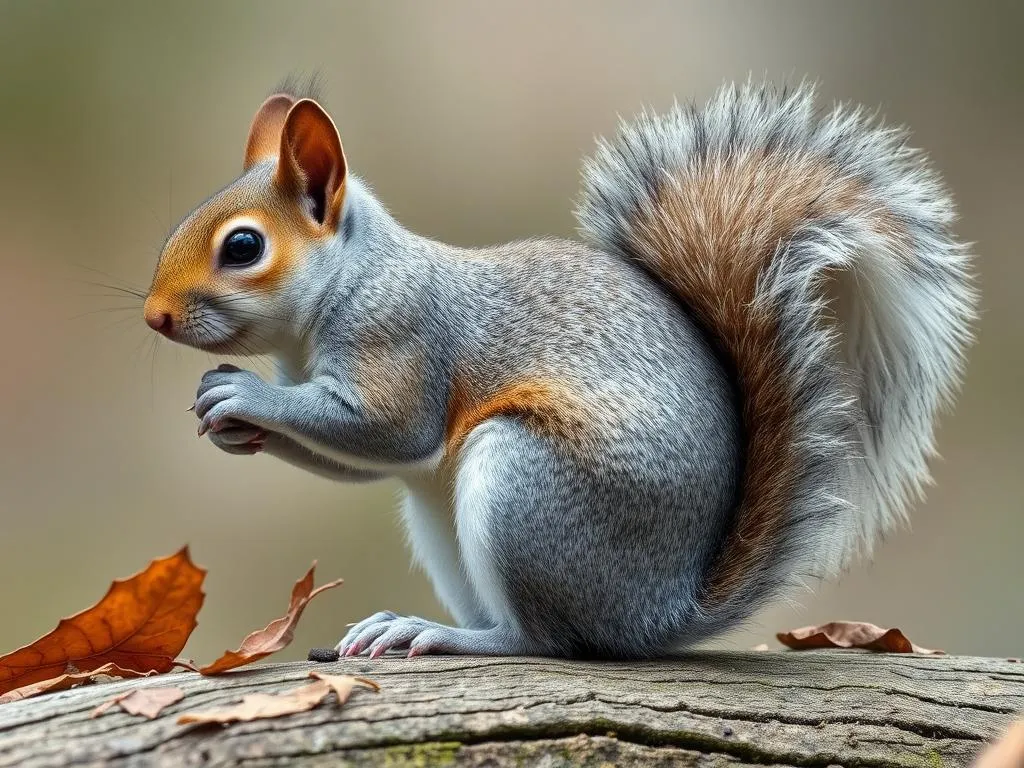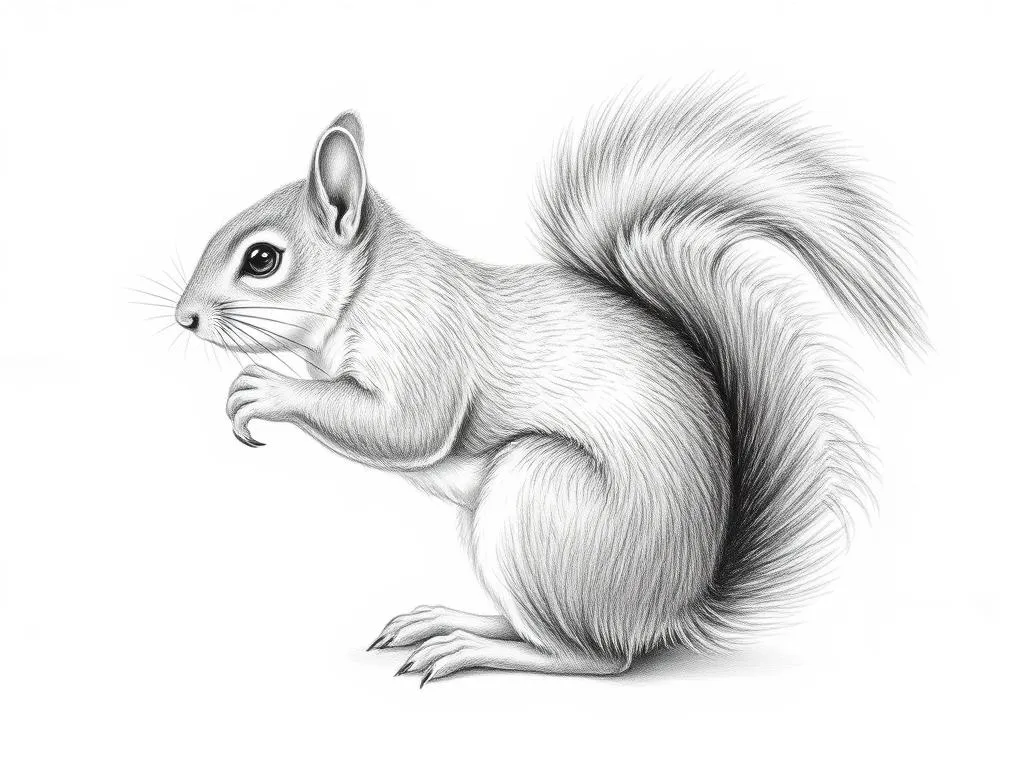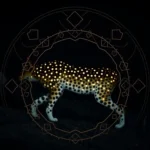The Eastern Gray Squirrel: A Symbol of Resourcefulness and Adaptability

Disclaimer: Some images on this website are AI-generated artworks and may not accurately represent real animals.
The eastern gray squirrel is more than just a common sight in parks and backyards; it serves as a powerful symbol of resourcefulness and adaptability. These small mammals represent the ability to thrive in various environments, making them a fascinating subject for study and reflection.
Understanding the Eastern Gray Squirrel
Physical Characteristics
The eastern gray squirrel (Sciurus carolinensis) is a medium-sized rodent that boasts distinct physical traits. Below is a summary of its primary characteristics:
| Feature | Description |
|---|---|
| Size | 18 to 24 inches (including tail) |
| Color | Gray fur with a white underbelly |
| Tail | Bushy and long, often as long as the body |
| Ears | Large and rounded |
| Eyes | Dark and shiny |
These squirrels are easily recognizable by their bushy tails and agility, which aid them in their arboreal lifestyle. Their coloration provides excellent camouflage among tree branches and foliage.
Habitat and Distribution
The eastern gray squirrel is native to North America and can be found in a variety of habitats. Their preferred environments include:
- Deciduous forests
- Urban parks and gardens
- Suburban neighborhoods
- Rural farmlands
These adaptable creatures thrive in both urban and rural settings, showcasing their resilience. Urban areas provide ample food sources, such as bird feeders and discarded food, while natural settings offer abundant nuts and fruits.
Behavioral Traits
The behavior of the eastern gray squirrel is as fascinating as its physical traits. They are known for their:
- Social Structure: While often solitary, they engage in social interactions, particularly during mating season. Males may compete for the attention of females, leading to playful chases.
- Foraging Habits: These squirrels are omnivorous and primarily eat nuts, seeds, fruits, and occasionally insects. Their impressive memory aids them in locating food caches hidden away for winter.
- Nesting Behaviors: They build nests called dreys, primarily located in trees. These nests are constructed from twigs, leaves, and other natural materials, providing shelter and warmth.

Symbolism & Spiritual Meaning
The eastern gray squirrel carries significant symbolism and spiritual meaning, resonating with many aspects of life.
Resourcefulness
One of the most notable traits of the eastern gray squirrel is its resourcefulness. Adaptability to various environments illustrates how we can navigate life’s challenges. Just as these squirrels find creative solutions to access food and shelter, we too can learn to be innovative and flexible in our pursuits.
Preparation and Planning
The habit of the eastern gray squirrel storing food for winter serves as a powerful metaphor for foresight and planning. By gathering and hiding nuts, they prepare for difficult times ahead, reminding us of the importance of being proactive in our own lives. This behavior encourages individuals to:
- Save for future needs
- Prepare mentally and emotionally for challenges
- Cultivate a mindset focused on long-term goals
Community and Social Bonds
In addition to their individual skills, the eastern gray squirrel demonstrates the significance of social bonds. Their interactions, whether through playful chases or grooming behaviors, highlight the value of community and support. This symbolizes the importance of building and nurturing relationships in our lives, fostering a sense of belonging and mutual assistance.
Eastern Gray Squirrel in Dreams
Dreams involving the eastern gray squirrel can carry deep meanings and interpretations. Understanding these symbols can provide insight into our subconscious thoughts and feelings.
Common Dream Scenarios
Dreaming about squirrels can manifest in various scenarios. Here are a few common ones:
| Dream Scenario | Potential Meaning |
|---|---|
| Squirrel gathering nuts | Preparing for future challenges |
| Squirrel playing or jumping | Embracing playfulness and lightheartedness |
| Squirrel hiding food | Seeking security and stability in life |
| Squirrel interacting with others | Importance of community and social connections |
Interpretive Themes
The themes associated with dreaming of eastern gray squirrels often revolve around:
- Abundance: Their gathering habits may symbolize the abundance available in one’s life or the potential for growth.
- Survival: Dreams can reflect a need to focus on survival and resource allocation, especially in times of uncertainty.
- Playfulness: Their playful nature often encourages a reminder to enjoy life despite challenges.
Personal Reflection
When encountering dreams featuring the eastern gray squirrel, it can be beneficial to reflect on your current life circumstances. Consider the following:
- Are there areas in your life where you need to be more resourceful?
- Are you adequately preparing for future challenges?
- How are your social connections impacting your well-being?
This personal reflection can lead to valuable insights and encourage positive changes.
Modern Interpretations
The eastern gray squirrel has a rich cultural significance, appearing in various forms across different societies and media.
Cultural Significance
Throughout history, many cultures have viewed the eastern gray squirrel as a symbol of resourcefulness and adaptability. In Native American folklore, they are often seen as messengers of preparation and foresight, reflecting the importance of planning for the future.
Symbol in Pop Culture
In modern times, the eastern gray squirrel has been represented in literature, movies, and art. They often symbolize:
- Cleverness: Their cunning nature is often highlighted in children’s stories and cartoons.
- Adaptability: Films featuring urban settings frequently include these squirrels as emblematic of city life.
- Nature’s resilience: Art and photography often capture their playful spirit, serving as a reminder of the beauty of wildlife.
Connection to Nature
Discussing the eastern gray squirrel also emphasizes the importance of urban wildlife. As cities expand, these creatures serve as vital indicators of environmental health. Their presence in urban areas reminds us of the need for conservation efforts and the significance of maintaining biodiversity.
Key Takeaways
Understanding the symbolism of the eastern gray squirrel can offer valuable lessons for life. Here are some key attributes associated with them:
- Resourcefulness: Embrace adaptability and innovative thinking in challenges.
- Preparation: Prioritize foresight and planning for future needs.
- Community Spirit: Foster and nurture relationships for support and connection.
Practical applications of these lessons can lead to personal growth and resilience.
Conclusion
The eastern gray squirrel serves as a potent reminder of the importance of understanding the symbolic nature of animals in our lives. Their embodiment of resourcefulness, adaptability, and community spirit provides valuable lessons that can inspire us to navigate our own challenges.
Take the time to observe these fascinating creatures in your environment. Reflect on the messages they may impart and consider how their behaviors can influence your approach to life. By recognizing the significance of the eastern gray squirrel, we can cultivate a deeper appreciation for the natural world and our place within it.







